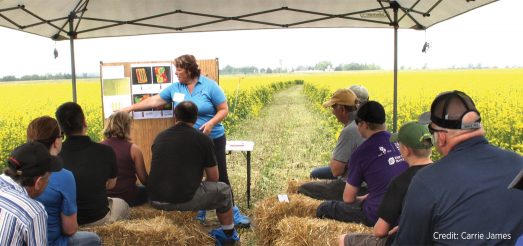Swede midge, clubroot challenge Ontario canola
Don Curry grows about 1,500 acres of canola near Owen Sound. He says that while he attends a lot of meetings, he was glad he made time for the agronomy event at Kenilworth in Wellington County. “It was a very high-caliber meeting and lot of thought went into it,” Curry says.
Kurt Krohn grows 90 acres of canola near Elmvale every four years, using a very strict rotation. He feels that the biggest concerns affecting canola growers are disease, insect pressure and crop price. He thought the meeting provided good information about improvements in planting equipment.
Hubert Beaudry farms about 1,800 acres in the Nipissing District near North Bay and usually grows about 500 acres of canola each year. He is also the vice president of the Ontario Canola Growers Association. Beaudry appreciates the opportunity to listen to other growers when he comes to meetings like this. “I try to learn from other people and sometimes change my own management based on what other people are doing,” he says.
Anything that affects yield, specifically insects and disease, are top of mind for Ontario canola growers. Curry found the session dealing with clubroot to be especially pertinent. While he has not experienced it first hand, he can see that it will be something Ontario growers need to be proactive about keeping under control.
Curry learned that best management practices for clubroot – including a longer rotation, resistant variety selection and having separate field entries and exits – can all help keep the disease-causing spores at a manageable level. Once the spores have moved into an area, it is easy to transport them on farm equipment from field to field. That’s why field entrances tend to be the first and most heavily infested areas. With a separate exit, it means equipment won’t leave through the most heavily infested area, picking up more spore-infested soil to transfer to another field.
Beaudry is concerned with swede midge and is being challenged by cutworms for the first time this year. He has been experimenting with a variety of cover crops, including clovers, rye, oats and tillage radish, and is wondering if this has played a role in his cutworm problem.
Beaudry and Curry are optimistic about the future of canola in Ontario. “I think it will hold its own,” says Curry. Beaudry says it is a perfect fit for areas of the province that aren’t well suited for corn and soybeans. “I will keep trying for sure,” says Beaudry. “I don’t give up easily.” For his part, Krohn is unsure.
Canola is a good option for growers in more northern parts of the province, and all three agree it is a great addition to a rotation that includes winter wheat. Because canola is harvested earlier than soybeans, it allows wheat to be planted earlier in the fall, which has a huge impact on wheat yields.
Krohn adds that better planting equipment could help growers have better stands. Specifically, he would like to see equipment that provides more accurate depth control and seed singulation.

in Ontario.
Beaudry feels that more research should be done on swede midge and its impact in Ontario. He feels that because Ontario is a relatively small market compared to other areas, chemical companies are not that concerned with advancing technologies to address swede midge.
As for the 2017 crop, weather has had the biggest impact so far. In Curry’s case, excess rain is causing him some concern. “I’ve never seen the effect that we’ve had this year – even on tiled ground there will be a yield impact,” he said. Krohn has also had a lot of moisture, but says his crop looks fantastic at this point. He adds that he is concerned about white mould (a.k.a. sclerotinia stem rot) and standability going towards harvest. Beaudry says his crop was thin at the beginning and he did some reseeding, but now it is looking good. “It was a struggle in the spring, but I’m actually impressed and now it is coming along fine,” he says.





